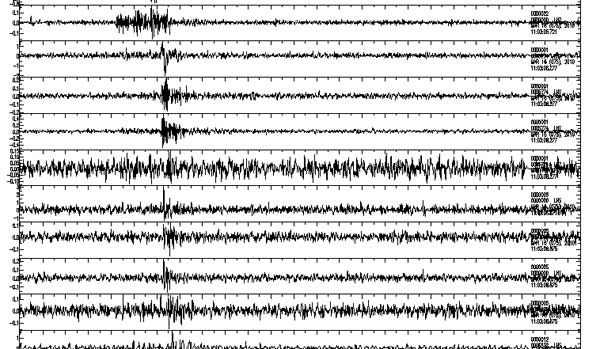Ordinary Laptops Act as Earthquake Detectors

Most people use their laptops for work and Web browsing. Now you can add one more task to that list: earthquake detection.
From the recent early-morning 4.4-magnitude jostle in Los Angeles to February's magnitude 8.8 disaster in Chile, ordinary laptops are increasingly acting as miniature seismic stations. They're part of a volunteer army known as the Quake-Catcher Network, which takes advantage of built-in accelerometers in newer laptops to transmit data about earthquakes to researchers at UC Riverside and Stanford University.
About 1,000 people from 61 countries have signed up so far. If the network gets large enough, researchers say, it could act as a low-cost earthquake warning system.
"It's providing additional data that can be fed into the seismic networks," said Elizabeth Cochran, a UC Riverside geoscientist. "It also allows us to record earthquakes at a scale that we haven't been able to before because of the cost."
Sensing motion
Cochran came up with the idea for the Quake-Catcher Network when she learned that most new laptops come equipped with accelerometers. These motion-detecting devices are designed to switch off the hard drive if the laptop is dropped.
"I figured that we could easily tap into this data and use it to record earthquakes," Cochran said.
Sign up for the Live Science daily newsletter now
Get the world’s most fascinating discoveries delivered straight to your inbox.
The Quake-Catcher software program, downloadable at qcn.stanford.edu, runs in the background on the laptop and becomes active when the user is idle.
When the accelerometers detect a quake, the program automatically transmits data about the type and intensity of shaking over the Internet to the researchers.
In the case of a power or Internet outage, the data is saved locally and transmitted later. Most of the time, Cochran said, earthquakes don't take out power and Internet immediately, so the software provides immediate data on at least the first few seconds of shaking.
To filter earthquake data from people bumping or dropping their laptops, the system only flags an earthquake when many computers in one area record motion at once.
These computer-based sensors aren't as sensitive as traditional seismic monitors, which can detect earthquakes of magnitude 1.0 or less. The lowest magnitude the Quake-Catcher Network can detect is about 4.0, a moderate quake much like the one that hit LA on March 16.
Six of the 30 to 50 laptops in the LA area reported that shaking, Cochran said. The largest quake the network has recorded was Chile's February 27 temblor, which was captured by a USB accelerometer being tested by a professor at the University of Concepcion in Chile.
An affordable quake detector
What the network lacks in sensitivity, it makes up for in price. Traditional seismic sensors cost $5,000 to $10,000 apiece. Laptop sensors are free, and desktop computers can be converted in less than 10 minutes with a $50 USB accelerometer.
Thousands more computers will be necessary before the network could be used to alert outlying areas of incoming earthquakes, but Quake-Catcher already provides data that other methods can't, said Paul Davis, a UCLA geophysicist who is not involved with the project.
"Traditional seismic stations are 10 to 20 kilometers [6 to 12 miles] apart," Davis said. "That makes it very difficult to look at fine details, both caused by the earthquake itself as well as by the ground shaking."
Hundreds or thousands of laptop sensors spread throughout urban areas could help engineers design better earthquake-resistant buildings and give geophysicists more information on how earthquake waves travel through the ground, Davis said.
Cochran hopes to bring 10,000 more volunteers onto the network in the next few years. Her team has already deployed 100 USB sensors in Chile to record aftershocks.
"Any data we collect, we basically just add that to the data we have on any particular earthquake," she said. "Every station is really important."

Stephanie Pappas is a contributing writer for Live Science, covering topics ranging from geoscience to archaeology to the human brain and behavior. She was previously a senior writer for Live Science but is now a freelancer based in Denver, Colorado, and regularly contributes to Scientific American and The Monitor, the monthly magazine of the American Psychological Association. Stephanie received a bachelor's degree in psychology from the University of South Carolina and a graduate certificate in science communication from the University of California, Santa Cruz.









